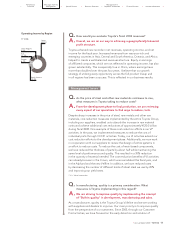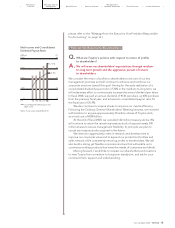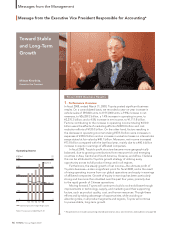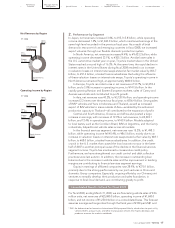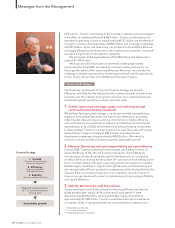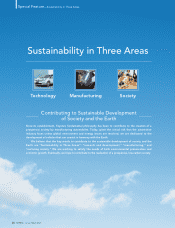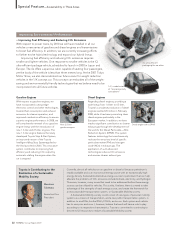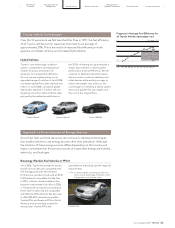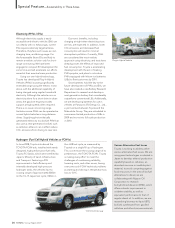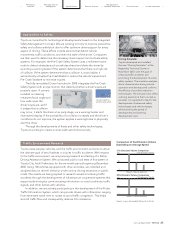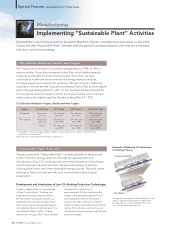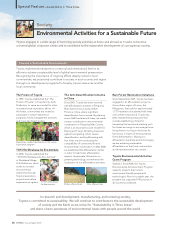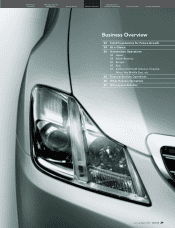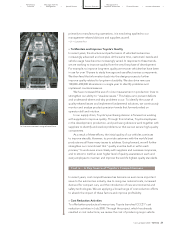Toyota 2008 Annual Report Download - page 23
Download and view the complete annual report
Please find page 23 of the 2008 Toyota annual report below. You can navigate through the pages in the report by either clicking on the pages listed below, or by using the keyword search tool below to find specific information within the annual report.
Performance Messages from the Management &
•Overview •Management •Special Feature •Business Overview •Corporate Information •Financial Section •Investor Information •
Technology
Achieving Sustainable Mobility
Technological innovations hold the key to the environmental preservation and economic growth that are
essential for us to contribute to a prosperous society and the Earth. Accordingly, Toyota is conducting research
and development aimed at the realization of an automotive society that can coexist with the Earth, or
Sustainable Mobility.
Based on the vision of “Zeronize & Maximize,” Toyota aims to minimize the
negative impact that vehicles have on the environment, while maximizing their
positive aspects, such as convenience, comfort, enjoyment, and excitement.
Under the above concept, we are conducting research and development
focused on the themes of the “environment,” “energy,” “safety,” and
“excitement.”
Considering the themes of the environment and energy, we believe that
these are the three major issues that must be addressed simultaneously with
respect to automobiles:
1. Supporting alternative energy sources;
2. Reducing CO2emissions (as a measure to counter global warming); and
3. Improving air quality.
Since fossil fuels are finite resources, it is imperative we use various
alternative energy sources. Accordingly, we need to determine the
appropriate energy sources for vehicles’ practical use as well as develop
power trains that are compatible with them, while also reducing CO2
emissions and ensuring cleaner exhaust emissions.
Targeting the realization of an ultimate eco-car, Toyota has long pursued
research and development of conventional gasoline and diesel engines, as
well as power trains that are compatible with such various energy as biofuel,
electricity, and hydrogen. Of these technologies, since hybrid technology
can be applied to all types of power trains, we have positioned it as a core
technology and are aggressively pursuing its development. Introducing these
R&D results in products, we are taking a multifaceted approach to providing
“the right vehicle, at the right time, in the right place.”
Automotive Society Issues and Toyota’s Vision for Future
1990
(Actual)
28%
2005
(Actual)
32%
2015
(Forecast)
2030
(Forecast)
9% 2%
2%
0
5,000
20,000
10,000
15,000 5%
22%
17,721
14,361
11,429
8,755
Crude oil equivalent (Million tons)
CY
Renewable energy, etc.
Biomass energy, etc.
Hydroelectric power
Nuclear power
Natural gas
Oil
Coal
Trends and Forecast of World
Energy Demand by Fuel
Source: Agency for Natural Resources and
Energy (Japan)
21
•Annual Report 2008 • TOYOTA
Scenarios for Response to Environmental and Energy Issues
2010
2030
Gasoline and diesel fuel Gasoline and diesel fuel
(from conventional oil fields)
Gasoline and diesel fuel
(from conventional oil fields)
Gas
Electricity
Hydrogen
Bioethanol
/biodiesel
Synthetic fuels
(GTL/CTL/BTL)
Gasoline and diesel fuel
(from deep-sea oil fields,
oil-shales, etc.)
Oil
Coal
Biomass
Nuclear energy
Hydro,
Solar, and
Geothermal energy
Natural gas
Internal
combustion
engine
EV
FCHV
Plug-in hybrid technologyHybrid technology
Drilling/refining technology/cost
Gas storage
technology
CO2 reduction technology
(during production of fuel)
Stabilize supply
Infrastructure development
Technology
utilizing
cellulose
Obtain desir
Obtain desired ed
prpropertiesoperties
Obtain desired
properties
Electrical storage
Electrical storage
technology technology
for PHVs and EVsfor PHVs and EVs
Electrical storage
technology
for PHVs and EVs
Infrastructure
development
CO2 reduction technology
(thermal power station)
CO2 reduction technology
(during hydrogen
production)
HydrHydrogen storage ogen storage
technologytechnology
Hydrogen storage
technology
Electrical storage
technology for EV
Build infrastructure
Electricity
generation
Hydrogen
production
Gasification/
Gasification/
synthetic synthetic
technologytechnology
Gasification/
synthetic
technology


